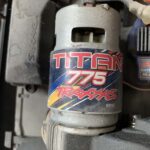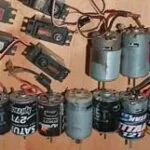How Hot Should A Brushless Motor Get [too hot can damage it]
Many people run their RC car thinking that because it’s brushless, it doesn’t produce heat, but it’s actually the other way around.
Although brushless motors have less friction than brushed, they do produce heat, and quite a lot of it.
As all motors, it has an ideal working temperature in order to perform the best.
Lets see how hot a brushless motor should get, and what temps are bad, and can even destroy your motor.
How Hot Should A Brushless Motor Run?
When operating a motor, brushless or not, it’s of the utmost importance to keep track of the temps they run at.
Running a brushless motor at very high temps for long periods of time can damage the rotor’s magnets, and without that, your brushless motor cannot run.
Your brushless motor should run around temps of 130°F – 150°F.
Do Brushless Motors Get Hot While Running?
If you’ve just bought your new brushless motor and if you’re not sure about how they work, then you may be wondering if brushless motors get hot while they run like their brushed counterparts do.
Brushless motors do indeed get hot while they run. In fact, they can reach 150F in under a minute, even without a load.
Why Do Brushless Motors Get Hot?
But what about the reason as to why brushless motors get hot?
A brushless motor gets hot due to the electrical current applied to it.
Not all of the current that you supply the brushless motor with will be used to power it.
Some of this current is actually lost and is converted into heat, which is why brushless motors tend to break faster if too high of a current is applied.
How Hot Is Too Hot For A Brushless RC Motor?
If you’re noticing that your brushless RC motor is getting a bit hot but you’re not sure if it’s actually too hot, then knowing what temp is detrimental to your brushless motor is imperative.
If your brushless motor is running at temps of 170°F or higher, then this is dangerous for your motor’s health.
What Happens When A Brushless Motor Overheats?
Brushless motors tend to overheat when a strong current from the power supply is applied, when the bearings begin to go bad, and when magnetism in the armature is beginning to weaken.
• Loss of magnetism in the armature which will lead to further overheating and the eventual breakage of your brushless motor.
• The adhesive inside of your brushless motor melting away and causing a complete failure of the armature.
• Damage to the bearings which allow for the armature to rotate smoothly.
However, most brushless motors have utilized the use of a fail-safe feature.
This feature is referred to as thermal overload protection, which will shut down the motor when dangerous temps are reached.
Can Running A Brushless Motor Too Hot Damage It?
Even though we previously mentioned the thermal overload protection feature present in most brushless motors, we must also consider the possibility that this feature could fail.
If this were to occur, we would be left with an overheating motor inside of our RC model and have no idea that overheating was happening.
However, the question still stands: can an overheating brushless motor cause significant damage?
Yes, an overheating brushless motor will take significant damage the longer it runs at such high temps.
A brushless motor that is overheating will eventually experience a critical failure, meaning that your motor will completely lose all functionality and will no longer work.
Do Brushless Motors Run Hotter Than Brushed Motors?
This is a common question from those of you who may not be as experienced in brushed Vs. brushless motors.
With that being said, do brushless motors run hotter than brushed motors?
No, brushless motors don’t run hotter than brushed motors, and this is due to the lack of friction that brushless motors boast.
While brushless motors can still reach high temperatures from the RC battery’s electrical current, the brushes in brushed motors create friction, which produces much more heat and creates far more wear and tear.
How Do I Keep My Brushless Motor Cool?
Before your brushless motor experiences a critical failure from the dreaded dilemma of overheating, it’s best to consider your options on how to cool your motor.
• Carefully cut small perforations in the body of your brushless motor to increase airflow, which will keep it cooler.
• Purchase a fan for your brushless motor. Many reputable manufacturers make fans that can be installed with relative ease.
• Buy a heat sink. A heat sink is a device that acts as a sort of sponge for heat produced by your brushless motor, and it will absorb most of the excess heat that threatens to destroy your brushless motor.
With these popular methods of cooling your brushless motor in mind, you should now be able to effectively keep your motor cool and free of heat related failures.
Do All Brushless Motors Run At The Same Temp?
This question is actually rather valid, as many seem to think that all brushless motors will produce the same amount of heat when paired with the same or similar power sources.
Actually, not all brushless motors run at the same temp, and this is due to the different manufacturers, how they create their motors, and what uses they have in mind for those specific motors.
For example, some brushless motors may have less perforations in the body, which leads to less airflow circulating through the motor and more frequent overheating.
How Do You Check Your Brushless Motor’s Temp?
If you have reason to believe that your brushless motor is overheating, such as smelling something burning or noticing that your RC model just isn’t running as well as it used to, then knowing how to check your motor’s temperature is essential to your motor’s longevity.
Purchasing a temp gun could make the difference between having a functional motor and having a broken one.
A temp gun uses an infrared laser to gauge the temperature of whatever it’s pointed at. When your brushless motor is running, you can use the temp gun to see if your motor is running at too high of a temperature, which allows you to take the necessary steps toward cooling it down.
For example, you should point your IR thermometer at the body of your brushless motor as it’s running, and keep the thermometer pointed at the body for approximately a minute.
Most brushless motors will heat up rather quickly, so you should be able to get a full reading quite easily. If the motor’s temp climbs to over 170F consistently, then it’s time to start considering sending your motor to a professional for diagnostics and repairs.
Conclusion
Your brushless motor should never reach 170°F or above and run at the temperature range of 130°F – 150°F.
you can check your motor’s temp with an infrared thermometer to keep tabs on its health.
Of course, we must not forget the risks of allowing your brushless motor to run too high, as this can damage the bearings inside, create a loss of magnetism in the armature, and can also lead to an utter failure of the motor.
As we bring things to a close, we hope you have a great time at the track and wish you happy bashing!
Sources used for this article
What is a Brushless DC Motor and How Does It Work?
BRUSHED VS BRUSHLESS MOTORS: WHAT’S THE DIFFERENCE?
KEEP YOUR BRUSHLESS MOTOR TEMPS DOWN TO KEEP YOUR SPEED UP!
Technical Manual Series: Types of Brushless Motors
Analysis of the Effect of the Motor Temperature to Brushless Direct Current Motor Performance





